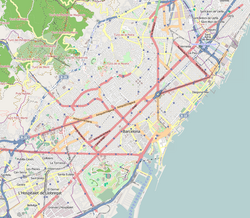| Ancient Synagogue of Barcelona | |
|---|---|
 Carrer Marlet, in the old Jewish quarter of Barcelona. The Sinagoga Major is on the left. | |
| Religion | |
| Affiliation | Judaism |
| Rite | Nusach Sefard |
| Ecclesiastical or organisational status |
|
| Status | Active (by arrangement) |
| Location | |
| Location | Jewish quarter, Barcelona, Catalonia |
| Country | Spain |
Location of the synagogue in Barcelona | |
| Geographic coordinates | 41°22′57″N2°10′33″E / 41.38250°N 2.17583°E |
| Architecture | |
| Type | Synagogue architecture |
| Completed |
|
| Specifications | |
| Direction of façade | East |
| Materials | Stone |
| Website | |
| sinagogamayor | |
| [1] | |
The Ancient Synagogue of Barcelona (Catalan : Sinagoga Major de Barcelona; Spanish : Sinagoga Mayor de Barcelona) is believed to be an ancient Jewish synagogue located in the Jewish quarter of Barcelona, Catalonia, Spain. Dating to as early as the 3rd century, the synagogue has been described as the oldest in Spain and one of the oldest synagogues in Europe. [2] [3] After many centuries of use for other purposes, the building re-opened as a synagogue and Jewish museum in 2002. No congregation prays regularly at the Ancient Synagogue, however it is used for festive occasions, such as B'nei Mitzvah and weddings. [4] [5]




